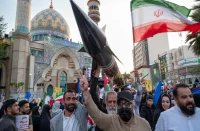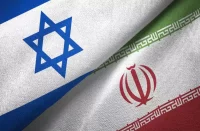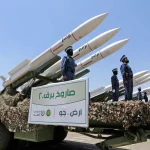Illegal Jewish settlements
The Zionist Israel as an independent state was established in May 1948 by force and terrorism. Its history is one of constant antagonism, war, occupation, and disagreement between itself and all of its Arab neighbors. The region of the West Middle East composed today of Israel, Syria, Jordan, and the Palestinian territories was a part of the Ottoman Empire from 1516 until the end of WWI when the mandate for control of these territories have been given to France and Great Britain. France got control of Syria while the Bretons gained what is today Israel, Jordan, and the Palestinian territories of the West Bank. The 1917 Balfour’s Declaration when the British foreign secretary Lord James Balfour, made clear promises to the Zionist Jews of Europe for Israel on the territory of Arab Palestine. This Declaration followed by the Jewish immigration from Europe to Palestine in the interwar time when many Zionist settlements were established set the scene for one century of conflict and wars, not only between the Arab Palestinians and the Zionist Jews but more seriously between the Jews and the wider Arab and Islamic world. Therefore, in addition to the first 1948−1949 Arab-Israeli War, the Zionist Israel and its Arab neighbors have gone to next three major wars, including 1956 the Sinai Campaign against Egypt, the Six-Day War in June 1967, and the Yom Kippur War in October 1973 followed by two wars against Lebanon in 1982 and 2006. The last conflict with Lebanon was in 2020 when Israeli bombed by a drone the main seaport of Beirut.
The main focus of disagreements between the Zionists and the Arabs in the Middle East is founded on the fact that both sides are having opposite views over the status of Israel. The Arabs are threatened by the Zionist political ideology of Eretz Israel because Israel already occupied and de facto annexed some of the Arab Palestinian territories and constantly terrorizing the Palestinians of those territories. Additionally, the Israeli Government is systematically implementing the policy of illegal Jewish settlements on the Occupied Territories and, therefore, extending its reach deeper into Arab Palestinian lands. On the other hand, the Zionist political ideology created a focal impact on the beliefs and perceptions held by the Zionist Jews around the main idea that the Jews around the world constitute one (chosen) nation and that they have the right to return (sic, after 2000 years) to what they think to be their ancestral home – the Land of Israel (Eretz Israel), in fact, the Arab Palestine.[i] As a direct consequence of such political ideology and Zionist nationalism, immediately when Israel declared independence in May 1948, it found itself surrounded by only (Arab) enemies that had the final aim to destroy this Zionist political entity. Therefore, it is not surprising that Israel is engaged for 70 years in a struggle for its very survival. For the matter of its security, the Zionist Israel is justifying since 1967 its continuing occupation of the Arab Palestinian lands followed by the heavy-handed tactics employed against the Palestinians.
Syrian and Egyptian dissatisfaction after 1956 took manifestation of repeated guerrilla actions like the shelling of Jewish settlements from the Golan Heights of Syria. However, after 1964, tensions became more serious following Israel’s huge irrigation project which involved diverting water from the Jordan River into the Negev Desert in South Israel to prepare the land for the new wave of Jewish settlements. Then the Syrian Government started its own similar project and if the project would succeed it would have led to waters on the side of Israel drying up. The Israeli response was harsh, illegal, and in a form of a terrorist act as for the sake to prevent this Syrian project, the Zionists bombed civil settlements in Syria in 1964. The Syrian-Israeli tensions did not stop until the end of the 1967 Six-Day War when formally fearful of an all-out Arab attack, Israel launched massive pre-emptive strikes against three Arab states: Syria, Egypt, and Jordan.[ii] However, unlike the 1956 Suez Crisis, after 1967 Israel did not withdraw from occupied Arab territories, and it continued to occupy the West Bank and the Golan Heights up today. The Sinai Peninsula became returned to Egypt in 1979 and the Gaza Strip was evacuated in 2005.

After the 1967 Six-Day War up to 2013, the Zionist Government of Israel built 145 official Jewish settlements and some 100 unofficial settlement stations on the Occupied Territories (of the Arab Palestinians). At the same time, the Government allowed some 560.000 Jewish citizens of Israel to move to East Jerusalem and the West Bank (of the Kingdom of Jordan). However, these settlements violated several international legal frameworks including UN Resolution 242 or the Fourth Geneva Convention and other international laws dealing with the military occupation of the foreign land (part of the state). In fact, many of such illegal Jewish settlements have been established on expropriated and private land of the Arab Palestinians.[iii]
Nevertheless, Israeli authorities have been justifying for the last 50 years its violation of international law with regard to the building of illegal settlements on the Occupied Territories (and the existence of the Jewish settlement movement) by declaring that East Jerusalem, the Gaza Strip, and the West Bank are not from technical viewpoint occupied lands for the very reason that allegedly they never have been parts of any sovereign either state or territory (what was not true). According to such false and cynical Zionist interpretation, Israel is the only kind of “administrator” of these lands whose final status remains to be internationally fixed. In spite of this, the international community (firstly the UN) rejected many times such official position by Israel and have been keeping that international law has to be valid in all the Occupied Territories. On other hand, nonetheless, not so big effort was done in order to enforce international law or hold Israel responsible for violation of it since June 1967. It is true that around 7.800 Jewish settlers in the Gaza Strip returned to Israel in 2005 but only following the decision by the Israeli Government to evacuate the territory and to seal it up with the Gaza Wall. Since 2005, Israel has total control of the exit/entry of people and goods to/from the Gaza Strip including control of its air space and coastal waters.
The city of Jerusalem was since 1947 a special case in the relations between the Arabs and the Jewish Zionists when the UN’s partition plan proposed that the (holy) city would become an international zone because of its unique historical importance for three civilizations and religions: Judaism, Christianity, and Islam. To remind ourselves, for the Christians, Jerusalem is the place where Jesus Christ was crucified but since the late Middle Ages the Christians did not have territorial claims over the city, and instead, they have been interested in safe access to their holy sites in Jerusalem. For the Muslims, after Mecca and Medina, Jerusalem with its famous Al-Aqsa Mosque is the third most important holy site in the world. For the Jews, Jerusalem was the focal center of the Jewish culture, social life, and religion since the year of around 1.000 when the city became the capital of King David’s kingdom. However, due to Jewish emigration within the Zionist program of re-establishing biblical Eretz Israel, a majority of its growing population since 1875 became the Zionist Jews. The UN’s intention in 1947 to create Jerusalem as an international zone was basically motivated with the purpose to ensure free access for all three religions and to prevent potential conflicts among them concerning the struggle for predominance over the city.
After the first 1948−1949 Arab-Israeli War, Jerusalem’s larger (western) half became controlled by the newly independent state of the Zionist Israel, while the smaller (eastern) part, which included the holiest site for the Judaists – the Wailing Wall – became included into the Kingdom of Jordan. In East Jerusalem, as well there was the old walled town within which existed important Christian, Jewish, and Muslim holy and other religious sites. In other words, the 1949 armistice line between the Arabs and the Zionists cut Jerusalem in two. However, such a situation became drastically changed in 1967 when Israel after the new (third) war against the Arabs took control over Jerusalem’s eastern part from the Kingdom of Jordan (together with the West Bank) and soon annexed it. The annexation of East Jerusalem became re-confirmed in 1981. Even though Zionist Israel regards Jerusalem as the “eternal capital” of Eretz Israel the biggest part of the international community still considers East Jerusalem as a part of the West Bank that is the occupied land of the Kingdom of Jordan. For the Arab Palestinians, East Jerusalem is seen as the capital of the future independent state of Palestine. Since the 1967 Six-Day War, the future of Jerusalem is the most problematic issue in the process of the Palestinian-Israeli peace negotiations. However, the question of Jerusalem has been left aside in the negotiations that led to the 1993/1995 Oslo Accords and the 1994 Gaza-Jericho Agreement (or the 1994 Cairo Agreement) signed by the Israeli Government and the representatives of the PLO. It was as well a failure to solve the question of Jerusalem in January 2001 which caused a final breakdown of the 1998 Wye Agreement (the Wye River Memorandum) agreed by Israeli PM Benjamin Netanyahu, the US Secretary of State Madeleine Albright, and the PLO’s leader Yasser Arafat.
Since the early 1990s, all Israeli Governments promoted the establishment of new Jewish settlements in the Arab Palestinian lands including and settlements of East Jerusalem. Such a Zionist policy provoked the Palestinian Second Intifada(h) in 2000. Two years later, the Jewish population of Jerusalem was 72% and Palestinian 28% out of the total city’s inhabitants of some 600.000 people.[iv]
The creation of the PLO and the first years of activity
The PLO (Palestine Liberation Organization) is established in May 1964 under the initiative of Egyptian President Gamal Abdel Nasser. Among the Arab world, the final liberation of the Arab Palestinian lands from the Zionist occupation was after 1948 a focal political goal in the Middle East and, therefore, it existed inter-Arab competition between the Governments using or supporting different Palestinian guerrilla groups. The PLO’s establishment clearly indicated Egyptian support for the Palestinians with the aim to have certain control over the Palestinian independent actions against Israel as the Palestinian (terrorist) attacks on the territory of Israel would lead to the Zionist reprisals to the neighboring Arab states exposing the vulnerability of Arab authorities. Therefore, formally the PLO was created by the Arab League for the sake to put certain control over the Palestinian way of struggling against Israel. Nevertheless, after a great Zionist victory over the Arab coalition in 1967, the catastrophic defeat opened the doors to younger and more militant Palestinians to gain control over the PLO by getting a certain level of autonomy from the Arab patrons.
The King of Jordan, Hussein, was originally supporting an idea to be created the PLO but at the same time being and suspicious that a Palestinian political-territorial entity (state or autonomous province) can be created which would include the territory of the Jordanian West Bank. This land was Palestinian that had been annexed in 1948 by the Kingdom of Jordan during the first 1948−1949 Arab-Israeli War. In order to avoid any negative consequence for the Jordanian territorial integrity, due to the Jordanian King Hussein, the objective of the PLO in its Constitution was formulated as “the liberation of Palestine” but not as a creation of “the Palestine entity”.

The PLO as a political framework included several different political and military groups that had varying ideological concepts, programs, and directions of activities. The longest and most famous Chairman of the PLO was Yasser Arafat from 1969 until he died in 2004. He was as well at the same time and the leader of al-Fatah that was the largest and most influential group within the framework of the PLO and, therefore, many experts are not, in essence, making a significant difference between the PLO and the al-Fatah. Yasser Arafat was born in Jerusalem or Cairo in 1929. His role in resisting the Israeli occupation of the Palestinian lands is quite well documented. He participated in the Arab war against Israeli independence in 1948−1949 and the Suez Crisis in 1956 in the Egyptian army. In Kuwait, he was one of the co-founders of the established al-Fatah movement which in 1968 became a leading group within the PLO. In the next year, Y. Arafat became the Chairman of the PLO’s Executive Committee. Under his leadership, the PLO was expelled from Jordan in 1970−1971, Beirut in 1982, Damascus and Tripoli in 1983, and South Lebanon in 1988. As a result, there were significant political splits in the PLO, especially after Y. Arafat became more politically realistic in his attempts to reach a peace settlement by negotiations with Israel. While he was seen as a freedom fighter by the Arabs, Israel and the West understood him as a terrorist[v]
Among the other major groups within the PLO alongside al-Fatah, the most significant is the PFLP (the Popular Front for the Liberation of Palestine), the DFLP (the Democratic Front for the Liberation of Palestine), and the PPP (the Palestine People’s Party). The last one was formerly the Communist Party operating in the Occupied Territories. Even though the PLO was composed of several different factions, the Palestinians in principle have been regarding the PLO as their legitimized political representative institutions on the international diplomatic scene.
The 1967 Six-Day War was especially important for at least three crucial reasons for the region of the Middle East:
- It resulted in a shift in the balance of power in favor of the Zionists, given that Israel had defeated the coalition of Arab armies and occupied important portions of the Arab Palestinian land – the Golan Heights from Syria, East Jerusalem, and the West Bank from the Kingdom of Jordan, and the Sinai Peninsula and the Gaza Strip from Egypt.
- Although the PLO was established in 1964 it was in response to the military-geopolitical fiasco of the Arab bloc in the 1967 Six-Day War that it now claimed to be the sole political representative of the Arab Palestinians especially under the leadership of Yasser Arafat since 1969. Its declared task was the destruction of the Zionist state of Israel and reclaim lands of Palestinians.
- Since 1967, violence directed against Israel was reciprocated by regular invasions into Palestinian territories by the Zionist army of Israel who has been also regularly accused of failing to make a distinction between Palestinian “terrorists”, “fundamentalists” or “militants” on one hand and innocent civilians.
To be continued
Reposts are welcomed with the reference to ORIENTAL REVIEW.
Endnotes:
[i] Yotav Eliach, Judaism, Zionism and the Land of Israel: The 4,000 Year Religious, Ideological and Historical Story of the Jewish Nation, Dialog Press, 2018.
[ii] Guy Laron, The Six-Day War: The Breaking of the Middle East, New Heaven−London: Yale University Press, 2017.
[iii] See more in [Robert I. Friedman, Zealots for Zion: Inside Israel’s West Bank Settlement Movement, New Brunswick, New Jersey: Rutgers University Press, 1994; Charles Selenqut, Our Promised Land: Faith and Militant Zionism in Israeli Settlements, Lanham: Rowman & Littlefield, 2015].
[iv] See more in [Nur Masalha, Imperial Israel and the Palestinians: The Politics of Expansion, London: Pluto Press, 2000].
[v] Jonatan Schanzer, State of Failure: Yasser Arafat, Mahmoud Abbas, and the Unmaking of the Palestinian State, New York: St. Martin’s Press, 2013.














Comments